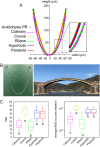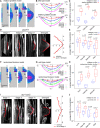Tissue growth constrains root organ outlines into an isometrically scalable shape
- PMID: 33637613
- PMCID: PMC7929931
- DOI: 10.1242/dev.196253
Tissue growth constrains root organ outlines into an isometrically scalable shape
Abstract
Organ morphologies are diverse but also conserved under shared developmental constraints among species. Any geometrical similarities in the shape behind diversity and the underlying developmental constraints remain unclear. Plant root tip outlines commonly exhibit a dome shape, which likely performs physiological functions, despite the diversity in size and cellular organization among distinct root classes and/or species. We carried out morphometric analysis of the primary roots of ten angiosperm species and of the lateral roots (LRs) of Arabidopsis, and found that each root outline was isometrically scaled onto a parameter-free catenary curve, a stable structure adopted for arch bridges. Using the physical model for bridges, we analogized that localized and spatially uniform occurrence of oriented cell division and expansion force the LR primordia (LRP) tip to form a catenary curve. These growth rules for the catenary curve were verified by tissue growth simulation of developing LRP development based on time-lapse imaging. Consistently, LRP outlines of mutants compromised in these rules were found to deviate from catenary curves. Our analyses demonstrate that physics-inspired growth rules constrain plant root tips to form isometrically scalable catenary curves.
Keywords: Anisotropic growth; Catenary curve; Developmental constraint; Organ shape; Plant root tip; Scaling.
© 2021. Published by The Company of Biologists Ltd.
Conflict of interest statement
Competing interestsThe authors declare that the research was conducted in the absence of any commercial or financial relationships that could be construed as a potential conflict of interest.
Figures





Similar articles
-
Lateral root morphogenesis is dependent on the mechanical properties of the overlaying tissues.Proc Natl Acad Sci U S A. 2013 Mar 26;110(13):5229-34. doi: 10.1073/pnas.1210807110. Epub 2013 Mar 11. Proc Natl Acad Sci U S A. 2013. PMID: 23479644 Free PMC article.
-
Early primordium morphogenesis during lateral root initiation in Arabidopsis thaliana.Planta. 2001 Nov;214(1):30-6. doi: 10.1007/s004250100598. Planta. 2001. PMID: 11762168
-
Genetic and Phenotypic Analysis of Lateral Root Development in Arabidopsis thaliana.Methods Mol Biol. 2018;1761:47-75. doi: 10.1007/978-1-4939-7747-5_4. Methods Mol Biol. 2018. PMID: 29525948
-
Patterning the primary root in Arabidopsis.Wiley Interdiscip Rev Dev Biol. 2012 Sep-Oct;1(5):675-91. doi: 10.1002/wdev.49. Epub 2012 Mar 22. Wiley Interdiscip Rev Dev Biol. 2012. PMID: 23799568 Review.
-
The organization of roots of dicotyledonous plants and the positions of control points.Ann Bot. 2011 May;107(7):1213-22. doi: 10.1093/aob/mcq229. Epub 2010 Nov 29. Ann Bot. 2011. PMID: 21118839 Free PMC article. Review.
Cited by
-
Live Plant Cell Tracking: Fiji plugin to analyze cell proliferation dynamics and understand morphogenesis.Plant Physiol. 2022 Feb 4;188(2):846-860. doi: 10.1093/plphys/kiab530. Plant Physiol. 2022. PMID: 34791452 Free PMC article.
-
Shaping root architecture: towards understanding the mechanisms involved in lateral root development.Biol Direct. 2024 Oct 2;19(1):87. doi: 10.1186/s13062-024-00535-5. Biol Direct. 2024. PMID: 39358783 Free PMC article. Review.
References
-
- Akaike, H. (1974). A new look at the statistical model identification. IEEE Trans Automat Contr. 19, 716-723. 10.1109/TAC.1974.1100705 - DOI
-
- Bassel, G. W., Stamm, P., Mosca, G., Barbier de Reuille, P., Gibbs, D. J., Winter, R., Janka, A., Holdsworth, M. J. and Smith, R. S. (2014). Mechanical constraints imposed by 3D cellular geometry and arrangement modulate growth patterns in the Arabidopsis embryo. Proc. Natl. Acad. Sci. U.S.A. 111, 8685-8690. 10.1073/pnas.1404616111 - DOI - PMC - PubMed
-
- Block, P., DeJong, M. and Ochsendorf, J. (2006). As hangs the flexible line: equilibrium of masonry arches. Nexus Netw J. 8, 13-24. 10.1007/s00004-006-0015-9 - DOI
Publication types
MeSH terms
LinkOut - more resources
Full Text Sources
Other Literature Sources
Miscellaneous

